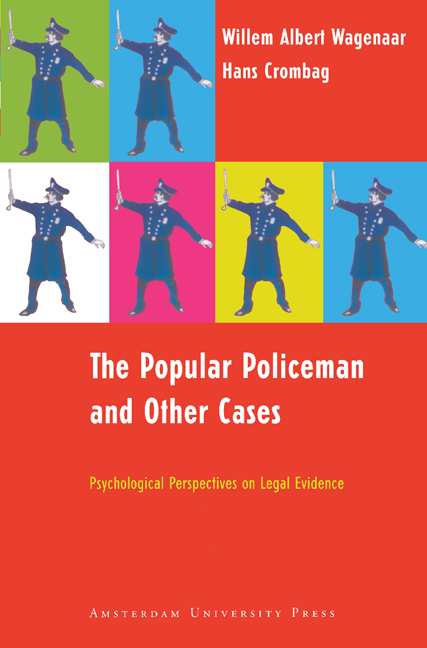Book contents
- Frontmatter
- Contents
- Foreword
- 1 Illegal Gambling or the Victory Travel Club
- 2 On Causal Reasoning or Death in the Warmoesstraat
- 3 Consumer Confusion or Potato Chips and Olive Oil
- 4 Fiction and Reality of ‘the Average Individual’ or the Case of Old Mr. Lane
- 5 Case Histories and Scientific Proof or the Case of JR
- 6 Not a Good Story or the Disappearance of Maddy and Vicky
- 7 Conflicting Scenarios or the Case of the Man who Needed a Companion
- 8 Two Processes Obstructing the Accuracy of Long-Term Memory or the Case of the Stolen Mercedes
- 9 Confessions after Repeated Interrogation or the Putten Murder Case
- 10 Collaborative Storytelling or the Artist’s Models and an Angry Neighbourhood
- 11 Allegation of Sexual Child Abuse in a Case of Disputed Visitation or Cindy's Story
- 12 Psychogenic Amnesia or the Case of the Amnesic Strangler
- 13 Obeying Reflexes or Death on the Climbing Wall
- 14 Visual Acuity or Shooting Mimi the Cat
- 15 Sexual Semiotics or the Case of the Popular Policeman
- Postscript: Psychological Expertise and the Law
- Bibliography
- Name Index
- Subject Index
10 - Collaborative Storytelling or the Artist’s Models and an Angry Neighbourhood
Published online by Cambridge University Press: 16 February 2021
- Frontmatter
- Contents
- Foreword
- 1 Illegal Gambling or the Victory Travel Club
- 2 On Causal Reasoning or Death in the Warmoesstraat
- 3 Consumer Confusion or Potato Chips and Olive Oil
- 4 Fiction and Reality of ‘the Average Individual’ or the Case of Old Mr. Lane
- 5 Case Histories and Scientific Proof or the Case of JR
- 6 Not a Good Story or the Disappearance of Maddy and Vicky
- 7 Conflicting Scenarios or the Case of the Man who Needed a Companion
- 8 Two Processes Obstructing the Accuracy of Long-Term Memory or the Case of the Stolen Mercedes
- 9 Confessions after Repeated Interrogation or the Putten Murder Case
- 10 Collaborative Storytelling or the Artist’s Models and an Angry Neighbourhood
- 11 Allegation of Sexual Child Abuse in a Case of Disputed Visitation or Cindy's Story
- 12 Psychogenic Amnesia or the Case of the Amnesic Strangler
- 13 Obeying Reflexes or Death on the Climbing Wall
- 14 Visual Acuity or Shooting Mimi the Cat
- 15 Sexual Semiotics or the Case of the Popular Policeman
- Postscript: Psychological Expertise and the Law
- Bibliography
- Name Index
- Subject Index
Summary
The artist and his models
Some years ago the nationally renowned sculptor Edward Green (a pseudonym) got in trouble with the criminal law. The favourite, although not exclusive, subject of his art is the female nude. Characteristic of his work is that it is both sensual and dynamic. The women he portrays are almost always young and beautiful, their postures highly sensual. Moreover, they are not portrayed in some static, more or less elegant posture, but looking at them, they appear to be moving. You can easily imagine what went on before and what is to follow. The combination of sensuality and dynamism gives his work an unmistakably erotic character, but it is by no means pornographic. The women are never portrayed as engaging in sexual behaviour.
Before modelling his subject in wax, Green makes many fast charcoal drawings of his models. Most of the time these models are dancers because, he says, dancers know how to express emotion in their movements. But dancers are not always available as models. Occasionally, he recruits models with the help of advertisements in local newspapers, but models thus recruited have little or no experience with modelling. They must learn how to do the job as they go along. Most of the models thus recruited turned out to be students at the nearby art academy. Sometimes they posed alone, sometimes in pairs.
For the drawings the models are asked to undress, and music is played. They are instructed to move with the music. But the music is not of the rhythmic kind to which you can dance in the way that every young person can. The music serves to create a somewhat ecstatic atmosphere. Its loudness makes communication between the artist and his model(s) impossible. Enveloped in a cloak of noise, the model is expected to surrender to the movement of her body and the emotions this arouses. She is not only expected to reveal her body, but also, and more importantly, her soul.
This is a difficult task. You are asked to put as much feeling and sensuality into your movements as you possibly can, but how do you do that?
- Type
- Chapter
- Information
- The Popular Policeman and Other CasesPsychological Perspectives on Legal Evidence, pp. 161 - 176Publisher: Amsterdam University PressPrint publication year: 2012



